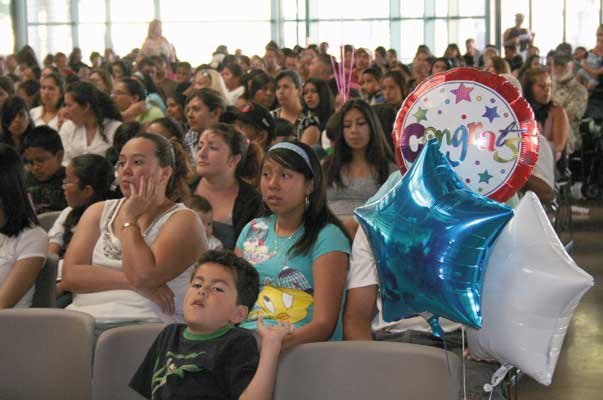Banners that read
”
Proud to Be Bilingual
”
fluttered overhead as more than 250 students of all ages
accepted certificates marking a pivotal milestone in their lives:
becoming fluent in the English language.
Banners that read “Proud to Be Bilingual” fluttered overhead as more than 250 students of all ages accepted certificates marking a pivotal milestone in their lives: becoming fluent in the English language.
“I’m proud to be English and Spanish,” said Kevin Espino Lopez, 10, a student at Rod Kelley Elementary School, after he stepped off the stage. “It’s cool to speak two languages. I can help my parents speak English or I can help speak Spanish to anyone that needs help.”
Espino Lopez joined students from the Gilroy Unified School District’s eight elementary schools and three middle schools, and Gilroy High School, Mount Madonna Continuation High School and the Gilroy Early College Academy to celebrate the culmination of years of hard work.
Hundreds of family members crowded into the Gilroy High School student center to greet their students with balloons and flowers. A cacophony of children’s voices filled the room with English and Spanish before and during the ceremony. Cameras flashed as parents maneuvered through the crowd to the front row when their student shook the superintendent’s hand.
Keynote speaker Ivan Rodriguez, a graduate of GUSD’s English learner program and a current student at the University of California, Berkeley, was reclassified in 1995 and happily shook his little sister’s hand as she marched across the stage to become the fourth member of the Rodriguez family to be reclassified.
“Today is a great moment for the entire family,” Rodriguez said after the ceremony.
Immigrants from Mexico, Rodriguez’s parents have assimilated into American culture but his mother is still learning the language, he said.
“Learning a new language is harder the older you get,” he said. “I would encourage people to start as soon as possible.”
Rodriguez’s older brother, Jairo, delivered the keynote address last year on his struggle to become bilingual. He pointed out that knowing two languages helps to bridge the gap between cultures. When he was reclassified 10 years ago, only 20 other students were at his side.
This year, Superintendent Deborah Flores, Mayor Al Pinheiro and school board President Javier Aguirre also took turns at the microphone.
“This ceremony marks an important point in our students’ lives,” Flores said. “I wish each of the students success in the next phase of their lives and look forward to recognizing them at future awards ceremonies.”
Pinheiro detailed, in English and Spanish, his journey from his home in Portugal when he was 12 years old with little English to help him get by.
Like Pinheiro, students come to California, and district schools, speaking myriad languages and possessing a range of English proficiency. If a student’s home language is not English, the student’s language proficiency is tested upon entering the district, said Angelina Rojas of the district’s specialized programs and accountability department. The student then goes through a series of bilingual classes – some of which take years to complete – before taking the California English Language Development Test. Success on the CELDT, along with positive teacher and parent evaluations and success on additional standardized tests, qualifies a student for reclassification.
The CELDT assesses listening and speaking skills of English learners in kindergarten and first grade, and listening, speaking, reading, and writing skills in grades two through 12. The skills and vocabulary tested become progressively more advanced as the children age.
The latest results of the district’s CELDT scores – released late last month – showed that 35 percent of Gilroy students who took the test performed at the advanced and early advanced levels – the top two performance bands. This is a five percentage point jump from last year’s scores. The district also managed to move 3 percent of its students out of the lowest two performance bands compared to last year.
Compared to the rest of the nation, California has the greatest number of students whose primary language is not English. More than 100 languages are spoken by the state’s English learners, of which approximately 85 percent speak Spanish, according to the California Department of Education.













